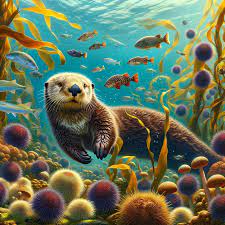| Contents Table of What Other Ways Could the Concept Map Include Keystone Species? What Species Are Keystone Exactly? How Did the Idea of the Keystone Species Originate? The Significance of Foundational Species Preserve Biodiversity Improve Services Provided by Ecosystems Boost the Resilience of the Environment Cultural Importance A Few Keystone Species Instances Hummingbirds: Sea Otters, African Elephants, Prairie Dogs, Beavers, and Native American How Are Keystone Species Identified? Examining Their Effect on the Environment Essential Qualities of Network Analysis Methods for Preserving Keystone Species Save the habitat Diminish Dangers Encourage Collaborations on Conservation Observe the Populations Final Thoughts on Including Keystone Species in the Concept Map A keystone species is what? How does biodiversity relate to keystone species? Are keystone species present in different types of ecosystems? |
“How could the concept map be enhanced with keystone species?” Go on an amazing journey through the ecosystems of Earth, where the presence of particular species, known as keystone species, profoundly shapes the fabric of life. These modest creatures have the incredible ability to influence the diversity and health of their surroundings, from the stately redwoods of California to the colorful coral reefs of the world’s tropical oceans. We will uncover the fundamental characteristics of keystone species, learn how to integrate them into our conceptual framework, and comprehend why they are so essential to the survival of many other species on Earth during this research.
What Other Ways Could the Concept Map Include Keystone Species?
- All populations within a community are more competitive when keystone species are present.
- The most prevalent species in a community are known as keystone species.
- Keystone species are always in symbiosis with other species.
- Communities’ diversity is influenced by keystone species.
The idea map bears the permanent imprint of keystone species, those essential members of the ecological symphony. Options are often presented along with the question, “How might you add keystone species to the concept map?”
Let’s now investigate the reasons behind this response’s resonance and the significant role keystone species play in ecosystem dynamics.
What Species Are Keystone Exactly?
The unsung heroes of biodiversity are keystone species, which are distinguished by the disproportionate influence they have on ecosystems in relation to their number. In contrast to the most abundant or massive organisms, keystone species are indispensable to preserving the equilibrium and functionality of their specific ecosystems. These species can be predators, herbivores, pollinators, or engineers, and they all play important roles in the complex dance of life within their own ecosystems. How the Concept Map Could Include Keystone Species.
How Did the Idea of the Keystone Species Originate?
The concept of keystone species has its origins in the pioneering tests carried out by ecologist Robert Paine in intertidal rocky coastlines throughout the 1960s. The removal of Pisaster ochraceus, the top predator, caused a domino effect, or how to add keystone species to the concept map. There was less diversity in the community as a result of the pisaster-prey mussel population increase. As a result of Paine’s observations, Pisaster was recognized as a keystone species, demonstrating its function in controlling the ecosystem’s structure and variety.
Since Paine’s groundbreaking research, keystone species have been discovered in a variety of habitats, highlighting their indirect impact on the distribution, abundance, or behavior of other species. The Significance of Foundational Species
Keystone species contribute to the complex balance of natural systems by having a significant impact on the health and variety of ecosystems. The following are the main points that emphasize their importance:
Preserve Biodiversity
By controlling the number and dispersion of other species, keystone species protect biodiversity. How might you include keystone species in the idea map to guarantee the peaceful coexistence of a wide range of living forms? They do this by managing populations, preventing overpopulation, or establishing habitats for a diversity of organisms.
Improve Services Provided by Ecosystems
Keystone species are frequently necessary for the provision of essential ecological services like carbon sequestration, nitrogen cycling, and water quality regulation. Beavers, for example, function as keystone species in wetland ecosystems by creating dams, which provide habitat and filter pollutants. The question is, “How might you add keystone species to the concept map?”
Boost the Resilience of the Environment
By acting as a buffer against environmental changes or promoting ecosystem recovery following disruptions, keystone species support ecological resilience. As keystone species in savannas, African elephants foster a variety of species’ habitats and increase their resilience to drought.
Cultural Importance
Numerous keystone species have cultural value because they are woven into myths, human history, and traditional knowledge. For millennia, indigenous populations in the Pacific Northwest have been supported by the salmon, a keystone species that offers food, economic resources, and cultural identity. A Few Keystone Species Instances
Explore the world of keystone species, which each have a special function in a variety of ecosystems:
Otters at Sea:
Sea otters prey on sea urchins, overgrazing is prevented, kelp forests flourish, and a variety of species, including fish that are crucial to the economy, have a home.
Elephants in Africa:
Africa’s vast savannas are home to keystone animals like elephants. They support a variety of species, produce habitat mosaics, aid in the cycling of nutrients, and disperse seeds through their browsing and grazing activities.
Dogs of the Prairie:
Prairie dogs are the cornerstone species of grassland ecosystems. In addition to improving soil quality and increasing water infiltration, these burrowing rodents feed hawks and coyotes.
Beavers:
Beavers are keystone species that are essential to the health of wetland ecosystems. Their skill in building dams results in ponds that sustain a wide variety of aquatic and terrestrial animals while controlling water flow and removing contaminants.
Hummingbirds:
In networks of plants and pollinators, hummingbirds become keystone species. By effectively pollinating a variety of plant species, they support a cascade of life and add to the resilience and stability of plant ecosystems.
How Are Keystone Species Identified?
Keystone species identification calls for a sophisticated strategy that integrates behavioral, ecological, and statistical research. The following are typical methods that scientists employ:
Examining Their Effect on the Environment
Keystone species have an ecological imprint that modifies other species’ diversity, abundance, or distribution in notable ways. When a species is added or deleted, significant changes are often noticed, which suggests that species may have keystone status.
Crucial Qualities
A species may be identified as a keystone based on specific characteristics or actions, such as altering its environment, controlling the cycling of nutrients, or assisting in pollination. Modeling or experimental manipulations aid in determining how important these characteristics are.
Network Examination
Through exploring the relationships between species in networks such as food webs, scientists identify the species’ centrality. A keystone species frequently plays an important role in bridging otherwise isolated species or trophic levels.
Methods for Preserving Keystone Species
Maintaining ecosystems depends on the protection of keystone species. Among the measures to protect these important contributors are: Preserve habitat
Keystone species’ survival is ensured by protecting their vital habitats. Protection of habitats can be achieved by the establishment of protected areas, restrictions on land use, and rehabilitation of degraded ecosystems.
Diminish Dangers
Keystone species are protected by reducing threats like pollution, hunting, and habitat degradation. Conservation activities clear the path for these important species’ survival by addressing these risks.
Encourage Collaborations on Conservation
Effective conservation requires cooperation between scientists, environmentalists, legislators, and local communities. By involving local people, effective, community-driven conservation plans may be developed and sustained support is ensured.
Observe the Populations
It is essential to regularly monitor keystone species populations in order to assess the success of conservation initiatives. Technologies for tracking, remote sensing, and population surveys help monitor their situation over time.
Final Thoughts on Including Keystone Species in the Concept Map
As managers of ecosystems, keystone species maintain resilience and biodiversity. Deciphering the complexities of their ecological roles enhances our understanding of the intricate network of life that supports our planet and guides conservation efforts. Equipped with this understanding, you’ll be able to confidently navigate the question the next time it comes up and explain the importance of keystone species in the overall ecosystems of Earth.
A keystone species is what?
An important organism that contributes disproportionately much to preserving an ecosystem’s structure and functionality is known as a keystone species.
How does biodiversity relate to keystone species?
Through affecting the distribution and abundance of other species, keystone species contribute to the maintenance of biodiversity. By affecting the number and distribution of other species within their ecosystem, keystone species contribute to the maintenance of biodiversity.
Are keystone species present in different types of ecosystems?
Indeed, keystone species can be found in a wide range of environments, such as grasslands, woodlands, and coral reefs.



